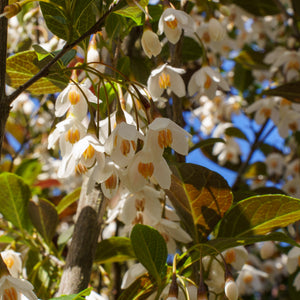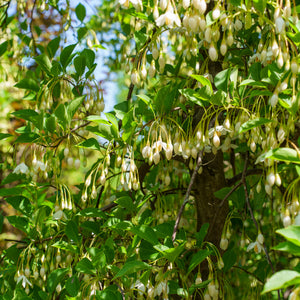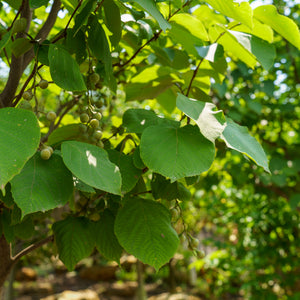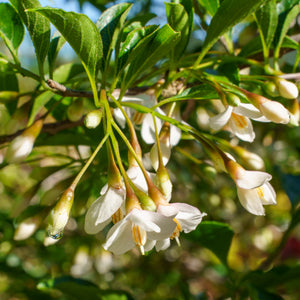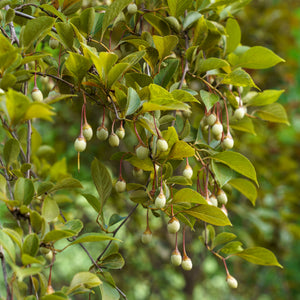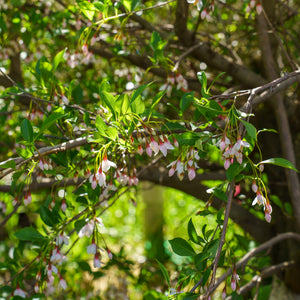The Styrax Guide
Styrax, commonly known as snowbell, is a genus of elegant flowering trees and shrubs celebrated for their pendulous, bell-shaped blooms and airy, refined habit. With a soft aesthetic and manageable size, Styrax trees are ideal for smaller landscapes, woodland edges, and understory settings. Their graceful form, fragrant flowers, and ornamental appeal through multiple seasons make them a standout choice for gardeners seeking beauty with minimal bulk.
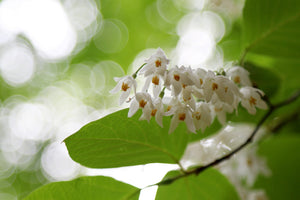
About
The most widely grown species is Styrax japonicus (Japanese snowbell), a small, deciduous tree native to East Asia. It typically reaches 20 to 30 feet in height with a rounded to broadly vase-shaped canopy and fine branching. In late spring to early summer, it bursts into a profusion of white, bell-shaped flowers that hang beneath the branches, creating a striking, chandelier-like effect. Many cultivars have been introduced for added color, fragrance, or form:
- 'Fragrant Fountain': Weeping habit and strongly scented white flowers.
- 'Evening Light': Deep purple foliage and white flowers for dramatic contrast.
- 'Pink Chimes' and 'Marley’s Pink': Light pink blooms for soft, romantic garden accents.
- 'Carillon': A true weeping form with elegant cascading branches.
Another species, Styrax obassia (Fragrant Snowbell), is native to Japan and Korea and grows taller (up to 40 feet). It features larger leaves, showier clusters of white flowers, and exfoliating bark for winter interest.
Styrax trees are known for their graceful outline, delicate flowers, and attractive foliage that turns golden yellow in fall. Their preference for partial shade and tolerance for filtered sun makes them excellent candidates for woodland gardens or sheltered courtyard plantings.
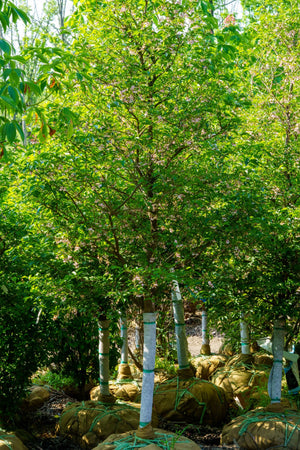
PLANTING
USDA Hardiness Zones: Zones 5–8 for most Styrax japonicus cultivars; Styrax obassia may tolerate colder zones with protection.
Soil: Prefers moist, well-drained, acidic soil enriched with organic matter. Avoid dry or compacted soils.
Sunlight: Performs best in part sun to dappled shade. In cooler regions, full sun is tolerated, while in hotter climates, afternoon shade prevents leaf scorch.
Watering: Requires regular watering, especially in the first few years. Deep, consistent moisture is key for healthy establishment.
Spacing: Allow 15 to 25 feet between trees depending on mature spread. Weeping forms require slightly less spacing.
Planting Time: Early spring or fall is best for planting. Avoid peak summer heat to reduce transplant stress.
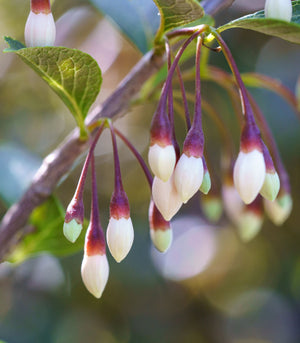
CARE
Watering: Maintain consistent moisture during the growing season. Mulch to preserve soil moisture and regulate temperature.
Fertilizing: Feed in early spring with a balanced, slow-release fertilizer. Supplement with compost or organic mulch to enrich the soil.
Pruning: Minimal pruning is required. Remove crossing or damaged branches in late winter. Light shaping can be done after flowering, but avoid removing too many of the pendant flowering branches.
Pests and Diseases: Generally pest- and disease-free. Watch for leaf scorch in hot, dry climates or chlorosis in high-pH soils.
Mulching: Apply 2–3 inches of organic mulch, such as bark or shredded leaves, keeping it a few inches from the trunk to prevent rot.
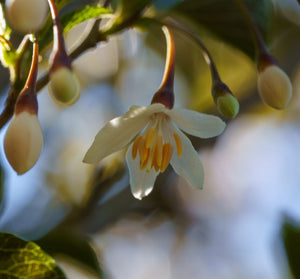
HOW TO USE
Focal Point Tree: Use Styrax as a showpiece in small gardens or near patios where its cascading blooms can be appreciated up close. Cultivars like 'Fragrant Fountain' or 'Marley’s Pink' create stunning visual moments in spring.
Understory Tree: Plant beneath taller canopy trees such as oaks, maples, or pines, where the dappled light mimics their native habitat and protects them from intense afternoon sun.
Woodland Garden Feature: Perfectly suited to naturalistic plantings with ferns, hostas, and azaleas. Their fine texture and subtle color harmonize with layered shade plantings.
Courtyard or Entry Garden: Compact cultivars like 'Pink Chimes' or 'Evening Light' make graceful additions to formal beds, especially when combined with ornamental grasses, hydrangeas, or heucheras.
Containers and Patios: Dwarf or weeping forms may be grown in large containers with careful attention to watering and winter protection in colder zones.
Fall Interest Planting: Though known for spring flowers, Styrax foliage turns a soft yellow in fall. Pair with deep green evergreens or red-foliage shrubs like Itea virginica for seasonal contrast.
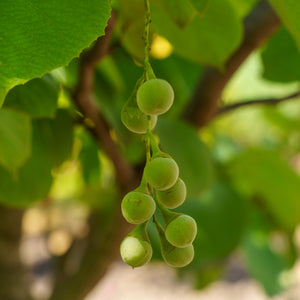
Common Questions
Do deer eat Styrax? Styrax is not a preferred food for deer, though young trees may be lightly browsed in times of scarcity.
Does Styrax grow well in hot weather? Styrax can struggle in extreme heat unless given afternoon shade and consistent soil moisture. In southern climates, filtered sun and mulch are recommended.
Does Styrax turn color in fall? Yes, Styrax foliage turns a gentle golden yellow in autumn, adding subtle fall interest to the landscape.
Can I prune a Styrax? Light pruning is fine and best done right after flowering. Avoid hard pruning or removing large limbs, as this can disrupt the tree’s naturally elegant habit.
Do Styrax need full sun? In cooler climates, full sun is acceptable, but in warmer zones, partial shade is preferred to avoid leaf scorch and heat stress.
Conclusion
Graceful, understated, and seasonally dynamic, Styrax trees bring quiet elegance to the landscape. With their pendulous, bell-shaped blooms and finely branching silhouettes, they offer visual softness in both sun and shade. Whether showcased as a focal point or nestled among other woodland plants, Styrax offers beauty without bulk and fragrance without fuss. Their adaptability, charm, and year-round interest make them a rewarding choice for gardens large and small.
The Styrax Collection
Sold Out
Sold Out
Sold Out
Sold Out

